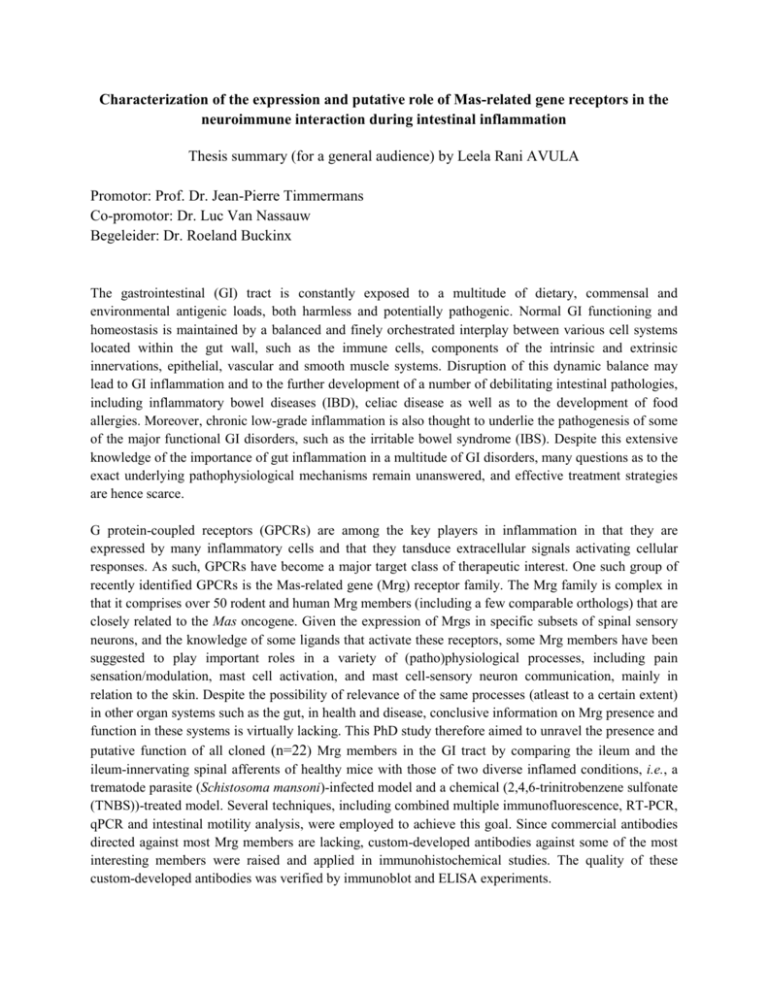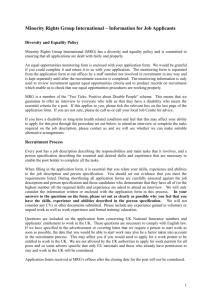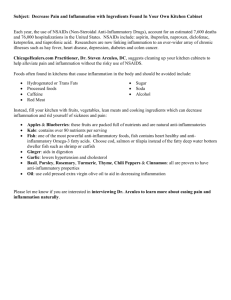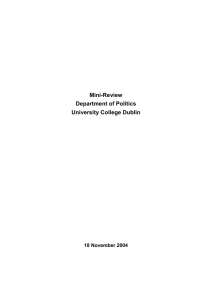translational bowel
advertisement

Characterization of the expression and putative role of Mas-related gene receptors in the neuroimmune interaction during intestinal inflammation Thesis summary (for a general audience) by Leela Rani AVULA Promotor: Prof. Dr. Jean-Pierre Timmermans Co-promotor: Dr. Luc Van Nassauw Begeleider: Dr. Roeland Buckinx The gastrointestinal (GI) tract is constantly exposed to a multitude of dietary, commensal and environmental antigenic loads, both harmless and potentially pathogenic. Normal GI functioning and homeostasis is maintained by a balanced and finely orchestrated interplay between various cell systems located within the gut wall, such as the immune cells, components of the intrinsic and extrinsic innervations, epithelial, vascular and smooth muscle systems. Disruption of this dynamic balance may lead to GI inflammation and to the further development of a number of debilitating intestinal pathologies, including inflammatory bowel diseases (IBD), celiac disease as well as to the development of food allergies. Moreover, chronic low-grade inflammation is also thought to underlie the pathogenesis of some of the major functional GI disorders, such as the irritable bowel syndrome (IBS). Despite this extensive knowledge of the importance of gut inflammation in a multitude of GI disorders, many questions as to the exact underlying pathophysiological mechanisms remain unanswered, and effective treatment strategies are hence scarce. G protein-coupled receptors (GPCRs) are among the key players in inflammation in that they are expressed by many inflammatory cells and that they tansduce extracellular signals activating cellular responses. As such, GPCRs have become a major target class of therapeutic interest. One such group of recently identified GPCRs is the Mas-related gene (Mrg) receptor family. The Mrg family is complex in that it comprises over 50 rodent and human Mrg members (including a few comparable orthologs) that are closely related to the Mas oncogene. Given the expression of Mrgs in specific subsets of spinal sensory neurons, and the knowledge of some ligands that activate these receptors, some Mrg members have been suggested to play important roles in a variety of (patho)physiological processes, including pain sensation/modulation, mast cell activation, and mast cell-sensory neuron communication, mainly in relation to the skin. Despite the possibility of relevance of the same processes (atleast to a certain extent) in other organ systems such as the gut, in health and disease, conclusive information on Mrg presence and function in these systems is virtually lacking. This PhD study therefore aimed to unravel the presence and putative function of all cloned (n=22) Mrg members in the GI tract by comparing the ileum and the ileum-innervating spinal afferents of healthy mice with those of two diverse inflamed conditions, i.e., a trematode parasite (Schistosoma mansoni)-infected model and a chemical (2,4,6-trinitrobenzene sulfonate (TNBS))-treated model. Several techniques, including combined multiple immunofluorescence, RT-PCR, qPCR and intestinal motility analysis, were employed to achieve this goal. Since commercial antibodies directed against most Mrg members are lacking, custom-developed antibodies against some of the most interesting members were raised and applied in immunohistochemical studies. The quality of these custom-developed antibodies was verified by immunoblot and ELISA experiments. The results indicate that in the healthy mouse ileum, most Mrg members were either not or only moderately expressed, showing a neuron-specific expression pattern. Interestingly, in the inflamed mouse ileum, significant changes in the expression patterns of some Mrg members were observed, for instance, expression of MrgA4, MrgB2 and MrgB8 was increased in enteric sensory neurons, expression of MrgE and MrgF was decreased in enteric cholinergic secretomotor neurons, and MrgB10 and MrgD showed de novo expression in enteric sensory neurons and in the newly recruited mucosal mast cells (MMCs). Significant changes with respect to the ileum-innervating spinal afferents were only observed for MrgA4, MrgE and MrgF during intestinal inflammation. The obtained results in mice provide clear evidence that specific Mrg members are involved in the inflammatory response during intestinal inflammation, particularly through their participation in primary afferent and MMC responses. MrgD was considered as one of the most interesting Mrg members, since a human ortholog exists, and since we found it to be de novo expressed in the mouse intestine following inflammation. Therefore, experiments were repeated in MrgD-/- mice in order to further elaborate its role. We observed in this knockout strain that lack of the MrgD gene and its corresponding receptor leads to increased expression of the sensory neuropeptide (calcitonin gene-related peptide (CGRP)) in enteric sensory neurons in both inflammation models, as well to increased numbers of MMC in the S. mansoni-infected mouse ileum compared to the wild-type animals. Moreover, certain parameters such as the villous diameter and crypt depth were also increased in this knockout strain during intestinal schistosomiasis. These findings clearly indicate role(s) for MrgD in the regulation of mastocytosis and/or sensory responses in intestinal inflammation. Based on the above findings, we further explored the role of MrgD in mast cell and sensory neuronassociated responses using immunohistochemistry, PCR and intestinal motility analysis. Immunohistochemical stainings showed that the MrgD-expressing MMCs and the CGRP-expressing nerve fibres in the lamina propria are in close association in the S. mansoni-infected mouse ileum, adding further support to our hypothesis of Mrg receptor involvement in the mast cell-sensory neuron cross-talk. β-alanine, a ligand for MrgD, could be a possible candidate mediator in the neuroimmune interactions. In this regard, it would be interesting to further explore the MrgD-mediated interaction between MMC and neurons. To investigate the activation of other Mrgs present on neurons and/or MMCs and to unravel their signal transduction pathways are also other interesting future research perspectives. When we compared the GI motility between healthy and S. mansoni-infected wild-type and MrgD-/- mice, we found no changes between the groups, indicating that MrgD-induced neuroimmune changes would primarily influence the sensory pathways during intestinal inflammation. In parallel, we identified MrgD expression in neurons and mast cells in the human intestine, suggesting possible translational potential and clinical relevance. This PhD study has unraveled the expression (and distribution) of all cloned Mrg receptors in the healthy and inflamed mouse ileum and in the ileum-innervating spinal ganglia. The expression of some of the relevant Mrg members in the human intestine has also been described. The study has clearly demonstrated the involvement of specific Mrg subtypes in intestinal inflammation, in particular in sensory neuronal and mast cell-associated responses. Together, our findings provide a strong basis for the further exploration of Mrg members, especially MrgD, as experimental targets in intestinal inflammatory pathologies, focusing on sensory perception and neuroimmune interactions.











